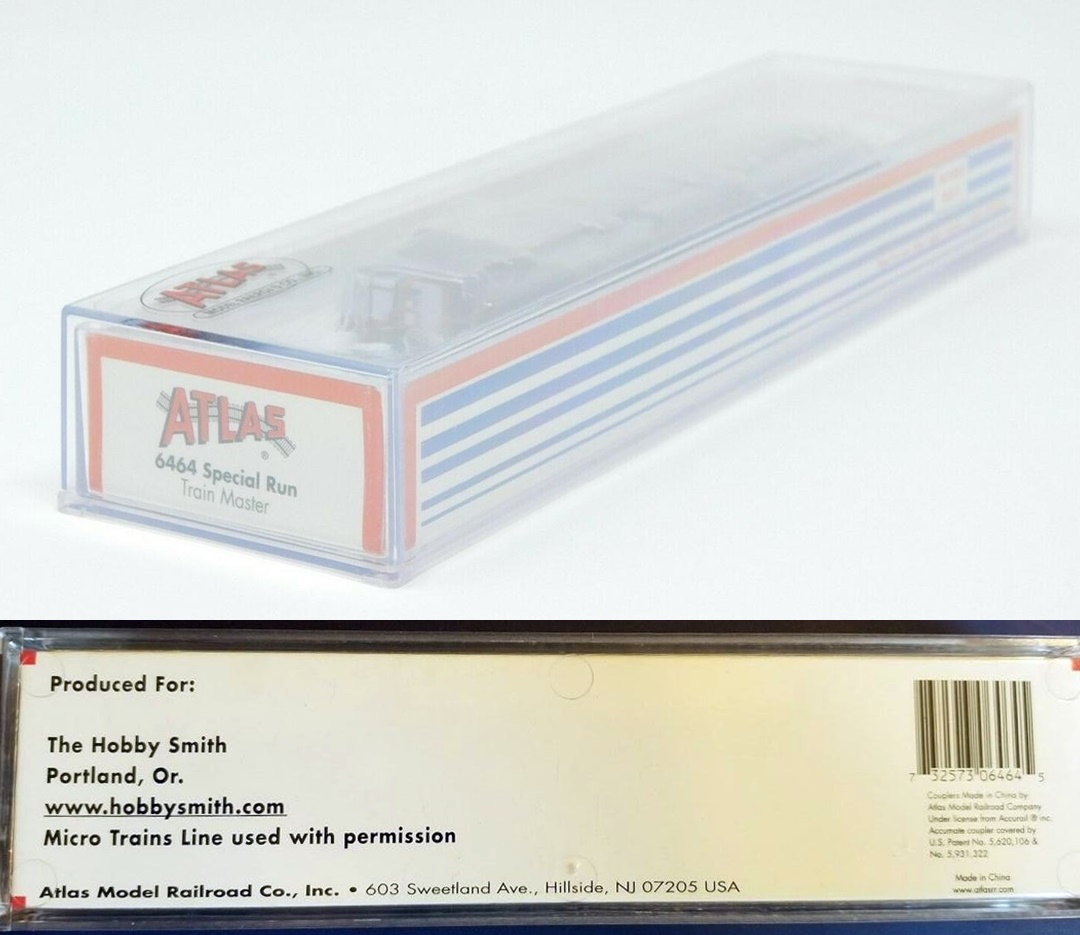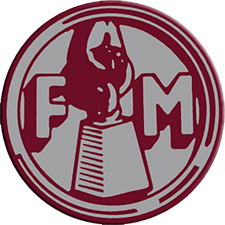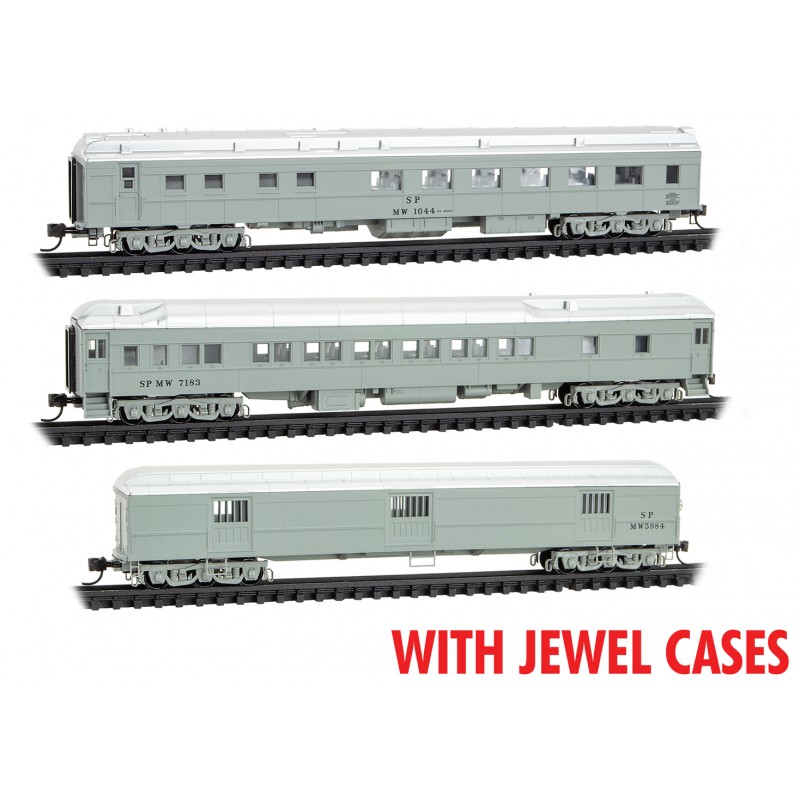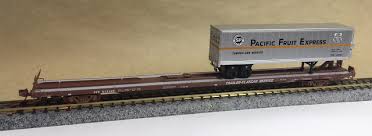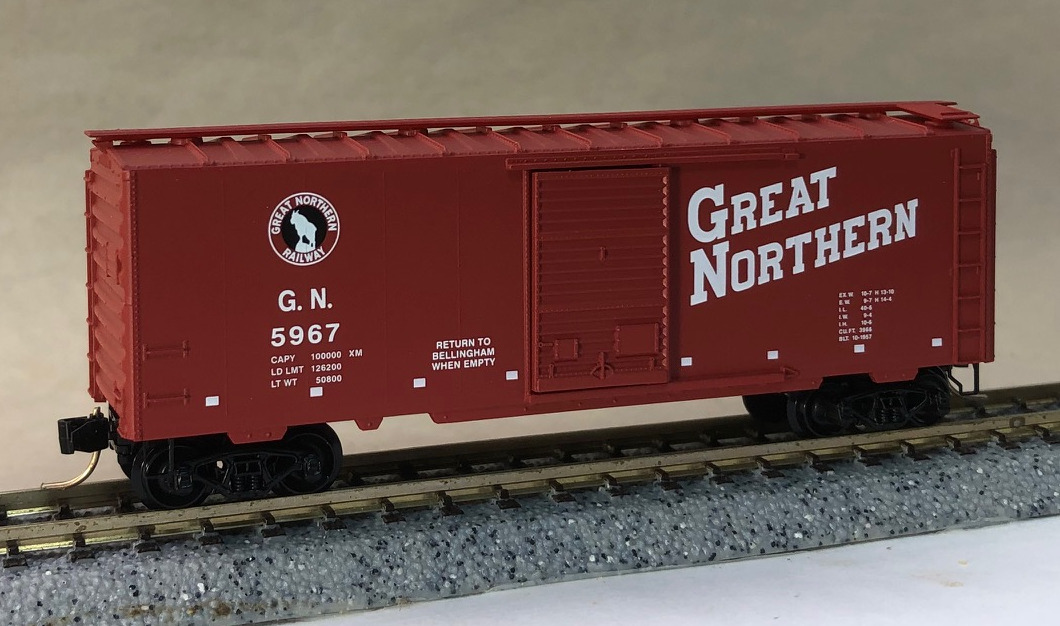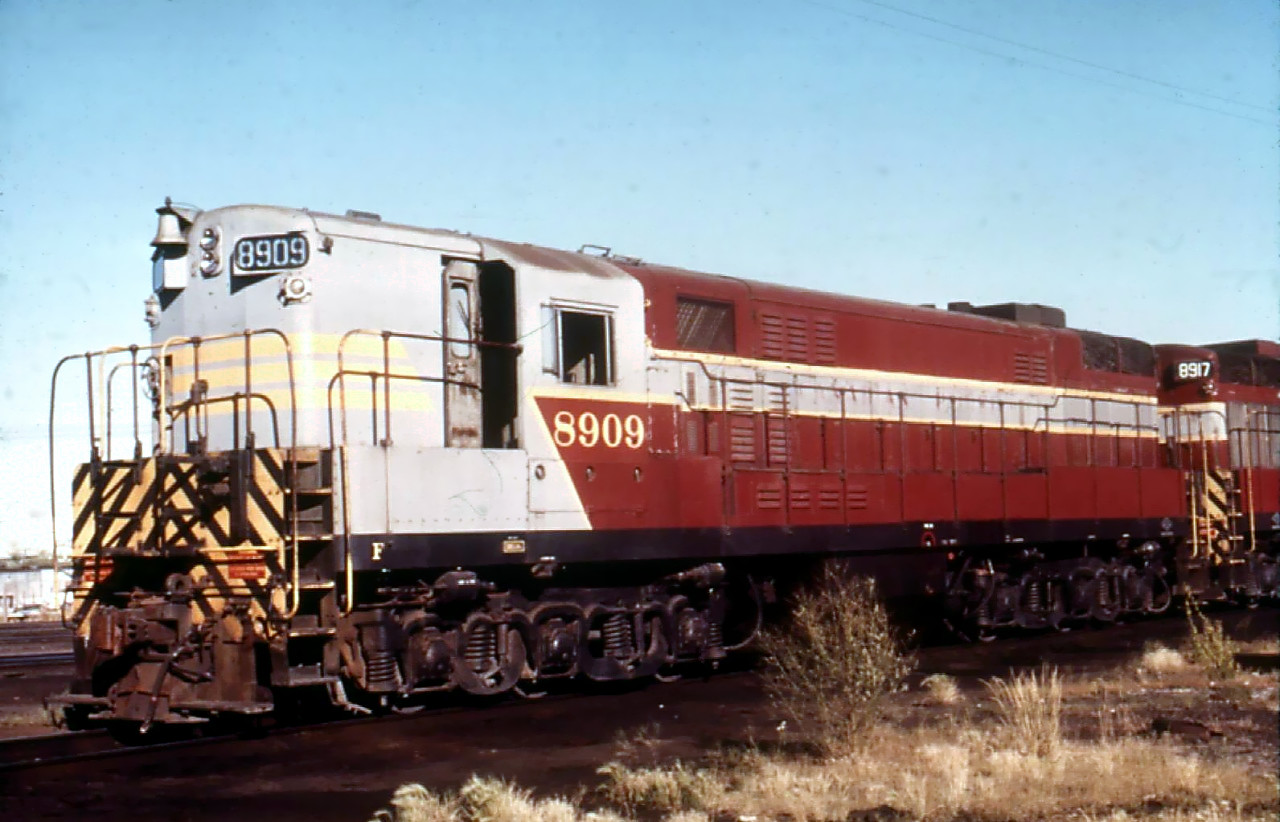Specific Item Information: This model can often be seen as 'Southern Pacific' #6464. Given the use of the SP Black Widow paint scheme, this is a natural temptation to re-badge it as an SP engine.
Series Information: 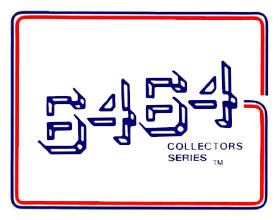 6464 Collector Series
6464 Collector Series
In the 1950′s and 60′s, most Lionel train sets included a boxcar. The common number ‘6464’ was printed on every car, regardless of the road name, and these cars have become a highly collected series for Lionel lovers throughout the world.
Lowell Smith commissioned Micro-Trains to reproduce these cars in N scale. He chose Micro-Trains because they are a company that, like Lionel, is a major brand name of trains that are both “collected and operated”.
This series began in 1995 and was projected to take seven years based on releasing six cars each year. The series was completed in 2002, as expected.
All cars were produced using the Micro-Trains 20,000 body style. At the end of the series, several “customer appreciation” sets were produced . Three locomotives and a caboose were released in conjunction with this series.
 6464 Collector Series
6464 Collector SeriesIn the 1950′s and 60′s, most Lionel train sets included a boxcar. The common number ‘6464’ was printed on every car, regardless of the road name, and these cars have become a highly collected series for Lionel lovers throughout the world.
Lowell Smith commissioned Micro-Trains to reproduce these cars in N scale. He chose Micro-Trains because they are a company that, like Lionel, is a major brand name of trains that are both “collected and operated”.
This series began in 1995 and was projected to take seven years based on releasing six cars each year. The series was completed in 2002, as expected.
All cars were produced using the Micro-Trains 20,000 body style. At the end of the series, several “customer appreciation” sets were produced . Three locomotives and a caboose were released in conjunction with this series.
Model Information: Atlas introduced its Fairbanks Morse Trainmaster model in late 2000. It is a modern mechanism with a split-frame, directional lighting, dual-flywheels, chemically blackened wheels and is drop-in decoder friendly. It has some great shell detail such as painted safety rails and etched metal grills.
DCC Information: Early versions accept a drop-in decoder.
Recent versions 'Silver Series, Sound Ready' accept ESU E24 decoders. The DC version is pre-equipped with a speaker.
Recent versions 'Silver Series, Sound Ready' accept ESU E24 decoders. The DC version is pre-equipped with a speaker.
Prototype History: The H-24-66 was a diesel-electric railway locomotive model produced by Fairbanks-Morse and its Canadian licensee, the Canadian Locomotive Company. These six-axle hood unit road switchers, nicknamed Train Masters, were deployed in the United States and Canada during the 1950s. Each locomotive produced 2,400 horsepower (1.8 MW). They were the successor to the ultimately unsuccessful Consolidated line of cab units produced by F-M and CLC in the 1950s. In common with other F-M locomotives, the Train Master units employed an opposed piston-design prime mover. The official model designation was H-24-66 and rode on a pair of drop equalized three-axle "Trimount" trucks giving it an C-C wheel arrangement.
Touted by Fairbanks-Morse as "...the most useful locomotive ever built..." upon its introduction in 1953, the 2,400 horsepower (1.8 MW) H-24-66 Train Master was the most powerful single-engine diesel locomotive available, legendary for its pulling power and rapid acceleration. While some railroads saw advantages in the Train Master's greater power, the perception on the part of others that the unit had too much horsepower (coupled with the difficulties inherent in maintaining the opposed-piston engine, inadequacies in the electrical system, and a higher-than-normal consumption of cooling water) contributed to poor marketplace acceptance of the Train Masters. Perhaps it was simply ahead of its time, as no competitor offered a locomotive with an equal horsepower rating until the ALCO RSD-7 entered production in January, 1954 (As an aside, the EMD SD24 did not arrive on the scene until July, 1958, and GE did not introduce their U25C until September, 1963). Both F-M and CLC ultimately left the locomotive business.
From Wikipedia
Touted by Fairbanks-Morse as "...the most useful locomotive ever built..." upon its introduction in 1953, the 2,400 horsepower (1.8 MW) H-24-66 Train Master was the most powerful single-engine diesel locomotive available, legendary for its pulling power and rapid acceleration. While some railroads saw advantages in the Train Master's greater power, the perception on the part of others that the unit had too much horsepower (coupled with the difficulties inherent in maintaining the opposed-piston engine, inadequacies in the electrical system, and a higher-than-normal consumption of cooling water) contributed to poor marketplace acceptance of the Train Masters. Perhaps it was simply ahead of its time, as no competitor offered a locomotive with an equal horsepower rating until the ALCO RSD-7 entered production in January, 1954 (As an aside, the EMD SD24 did not arrive on the scene until July, 1958, and GE did not introduce their U25C until September, 1963). Both F-M and CLC ultimately left the locomotive business.
From Wikipedia
Road Name History: Micro-Trains sometimes makes fantasy cars using their own company name as the railroad name.
Brand/Importer Information: In 1924 Stephan Schaffan, Sr. founded the Atlas Tool Company in Newark, New Jersey. In 1933 his son, Stephan Schaffan, Jr., came to work for his father at the age of sixteen. Steve Jr. built model airplanes as a hobby and frequented a local hobby shop. Being an enterprising young man, he would often ask the owner if there was anything he could do to earn some extra spending money. Tired of listening to his requests, the hobby-store owner threw some model railroad track parts his way and said, "Here, see if you can improve on this".
In those days, railroad modelers had to assemble and build everything from scratch. Steve Jr. created a "switch kit" which sold so well, that the entire family worked on them in the basement at night, while doing business as usual in the machine shop during the day.
Subsequently, Steve Jr. engineered the stapling of rail to fiber track, along with inventing the first practical rail joiner and pre-assembled turnouts and flexible track. All of these products, and more, helped to popularize model railroading and assisted in the creation of a mass-market hobby. The budding entrepreneur quickly outgrew the limitations of a basement and small garage operation. Realizing they could actually make a living selling track and related products, Steve and his father had the first factory built in Hillside, New Jersey at 413 Florence Avenue in 1947. On September 30, 1949, the Atlas Tool Company was officially incorporated as a New Jersey company.
In 1985, Steve was honored posthumously for his inventions by the Model Railroad Industry Association and was inducted into the Model Railroad Industry Hall of Fame in Baltimore, Maryland. In addition, Steve was nominated and entered into the National Model Railroad Association Pioneers of Model Railroading in 1995.
In the early 1990s, the Atlas Tool Company changed its name to Atlas Model Railroad Company, Inc.
In those days, railroad modelers had to assemble and build everything from scratch. Steve Jr. created a "switch kit" which sold so well, that the entire family worked on them in the basement at night, while doing business as usual in the machine shop during the day.
Subsequently, Steve Jr. engineered the stapling of rail to fiber track, along with inventing the first practical rail joiner and pre-assembled turnouts and flexible track. All of these products, and more, helped to popularize model railroading and assisted in the creation of a mass-market hobby. The budding entrepreneur quickly outgrew the limitations of a basement and small garage operation. Realizing they could actually make a living selling track and related products, Steve and his father had the first factory built in Hillside, New Jersey at 413 Florence Avenue in 1947. On September 30, 1949, the Atlas Tool Company was officially incorporated as a New Jersey company.
In 1985, Steve was honored posthumously for his inventions by the Model Railroad Industry Association and was inducted into the Model Railroad Industry Hall of Fame in Baltimore, Maryland. In addition, Steve was nominated and entered into the National Model Railroad Association Pioneers of Model Railroading in 1995.
In the early 1990s, the Atlas Tool Company changed its name to Atlas Model Railroad Company, Inc.
Commissioner Information:  Desiring to bring a creative and artistic approach to model railroad cars, Lowell Smith Signature Series was born in 1994. The first special run car commemorated the Sesquicentennial (150th anniversary) of the Golden Spike - "Wedding of the Rails". Since 1994, Lowell Smith Signature Series has continued to produce over one hundred and thirty-five unique cars or train locomotives to date.
Desiring to bring a creative and artistic approach to model railroad cars, Lowell Smith Signature Series was born in 1994. The first special run car commemorated the Sesquicentennial (150th anniversary) of the Golden Spike - "Wedding of the Rails". Since 1994, Lowell Smith Signature Series has continued to produce over one hundred and thirty-five unique cars or train locomotives to date.
A native of Portland, Oregon, Lowell Smith married his church choir sweetheart Barb in 1978. After a lifetime of rail-fanning, Lowell and Barb ventured out in 1992 to launch a new business in Portland, Oregon.
Following Lowell's passion of model trains, The Hobby Smith was built to be the community center for model railroaders - operators and collectors alike. Located in the Hollywood District of Portland, The Hobby Smith was the place to learn and to enjoy the camaraderie of others with the same passion.
A native of Portland, Oregon, Lowell Smith married his church choir sweetheart Barb in 1978. After a lifetime of rail-fanning, Lowell and Barb ventured out in 1992 to launch a new business in Portland, Oregon.
Following Lowell's passion of model trains, The Hobby Smith was built to be the community center for model railroaders - operators and collectors alike. Located in the Hollywood District of Portland, The Hobby Smith was the place to learn and to enjoy the camaraderie of others with the same passion.
Item created by: Alain LM on 2022-03-01 08:44:12. Last edited by Alain LM on 2022-03-01 11:27:44
If you see errors or missing data in this entry, please feel free to log in and edit it. Anyone with a Gmail account can log in instantly.
If you see errors or missing data in this entry, please feel free to log in and edit it. Anyone with a Gmail account can log in instantly.



